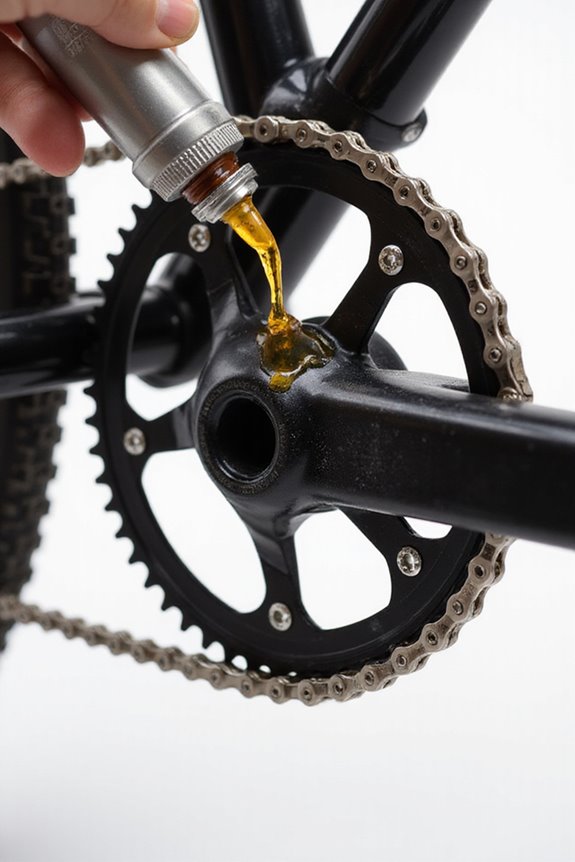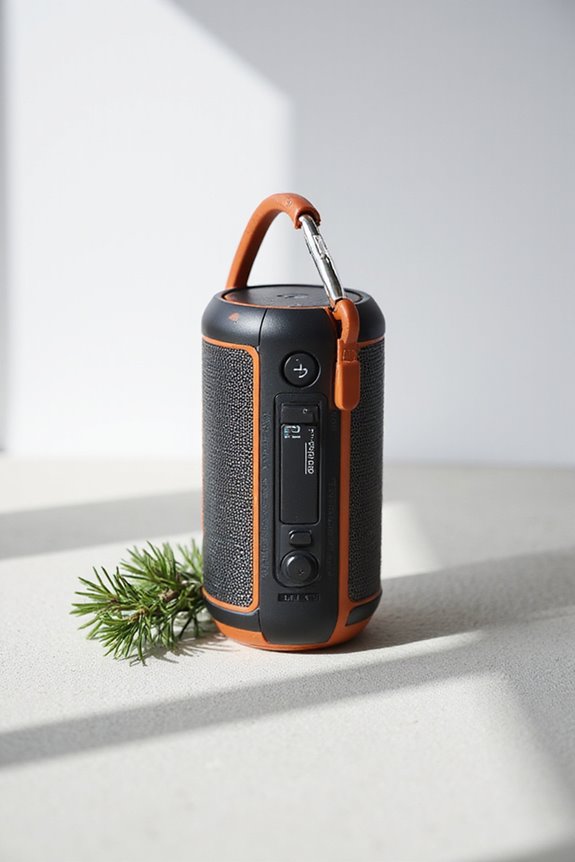Lubricating a bicycle chain is simple but essential! Start by giving that chain a good clean with mineral spirits, soaking it for about 15 minutes. Once it’s dried, grab a wet, dry, or wax-based lubricant—just avoid drowning it. Apply a bit on the inner edges and backpedal to spread it around, wiping off any messy drips. Regular maintenance, like cleaning and inspecting for rust, keeps every ride smooth and hassle-free. There’s more to learn about keeping your chain happy!
Key Takeaways
- Clean your chain thoroughly using solvents like mineral spirits or naphtha before lubrication to ensure optimal performance.
- Choose the appropriate lubricant based on weather conditions: wet for rain, dry for sunny days.
- Apply a small amount of lubricant to the inner edge of each roller to avoid excess mess.
- Backpedal the cranks to evenly distribute lubricant and ensure comprehensive coverage across the chain.
- Regularly inspect and clean your chain every 200 kilometers to maintain its health and prolong its lifespan.
Importance of a Well-Lubricated Chain
When it comes to cycling, one might think that the bike’s frame and tires get all the glory, but the unsung hero of a smooth ride is actually the bicycle chain. A well-lubricated chain plays an essential role in enhancing performance, ensuring friction reduction between metal components, which means less energy wasted. Imagine gliding effortlessly, feeling that sweet power efficiency as you conquer hills. Plus, good lubrication doesn’t just keep things slick; it also brings noise reduction to the table, transforming that clunky ride into a whisper-quiet adventure. Maintenance isn’t just about keeping things running; it’s about prolonging the lifespan of your chain and enhancing your overall cycling experience. After all, who doesn’t want a smoother, quieter journey?
Preparing Your Chain for Lubrication
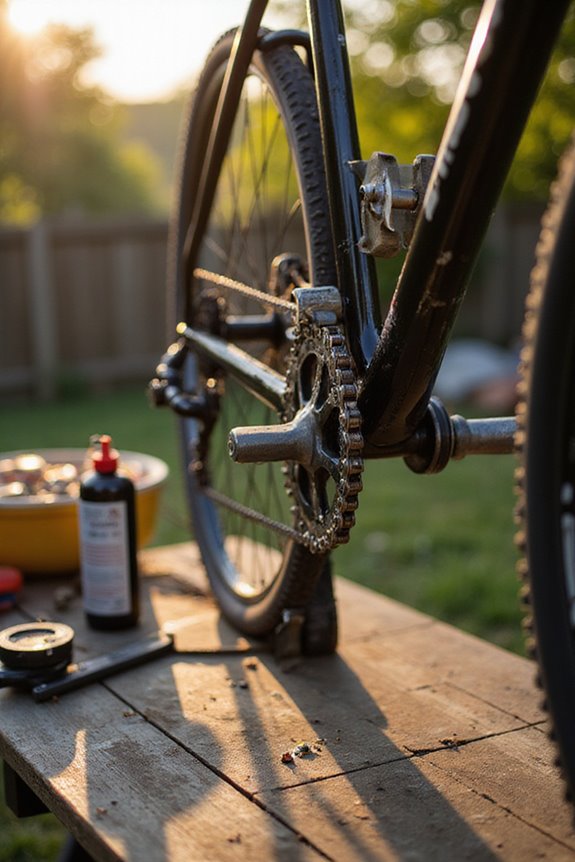
Lubricating a bicycle chain isn’t just about slapping on some oil and calling it a day; it’s a whole process that begins with properly preparing the chain. First up is chain cleaning, which involves choosing effective solvents like mineral spirits or naphtha to cut through grime and remove those pesky factory lubricants. A quick soak of about 15 minutes works wonders, but don’t forget to agitate the chain to loosen stubborn dirt. After a thorough rinse, let the chain air dry completely—moisture is a no-no! Finally, give it a good visual inspection to verify it’s spotless and ready for lubrication. With these steps, the chain will be primed for peak performance, making every ride smoother and more enjoyable.
Choosing the Right Lubricant
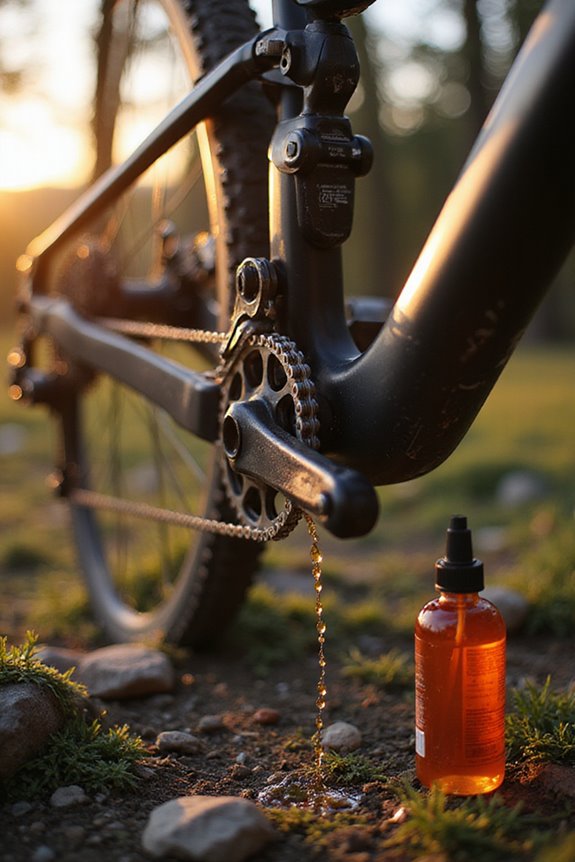
How does one choose the right lubricant for a bicycle chain amidst the dizzying array of options? First, consider the lubricant types: wet lubes excel in rainy weather, creating a protective barrier, while dry lubes shine in sunshine, attracting less dirt. For those who want a little bit of everything, wax-based lubes claim versatility but may need frequent applications. If durability is a concern, ceramic lubricants offer an edge. Eco-conscious cyclists might lean towards biodegradable lubes, made from natural ingredients, which help reduce environmental impact. However, one should note that performance can vary compared to traditional options. Ultimately, the right choice balances conditions and personal values, ensuring a smooth ride while being kind to Mother Earth.
Thinning Your Lubricants for Better Performance
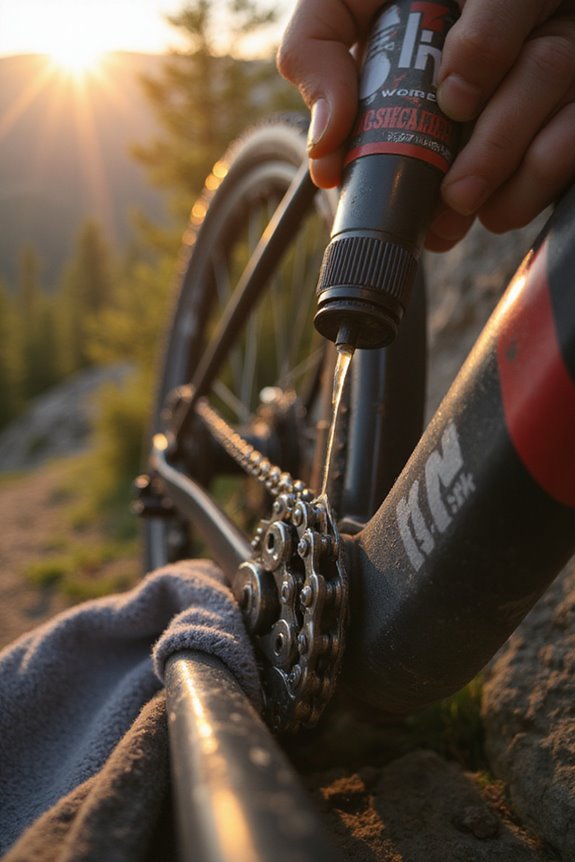
Thinning lubricants can feel like a secret sauce that elevates a bike’s performance, especially when riders discover the magic of improved flow and penetration. Using thinner types, like diesel, can transform a chain’s dynamics, allowing that silky smooth ride everyone craves. This thinning process lowers viscosity effects, helping the lube seep into every nook and cranny of the chain, while also cleaning off grime. Imagine gliding effortlessly down a trail, knowing your chain is protected and clean! However, it’s essential to match the thinner to your riding conditions—rainy days might call for different strategies than sunny rides. Remember, while thinned lubricants can boost performance, they may need more frequent applications, so keep those maintenance habits in check!
Proper Application Techniques
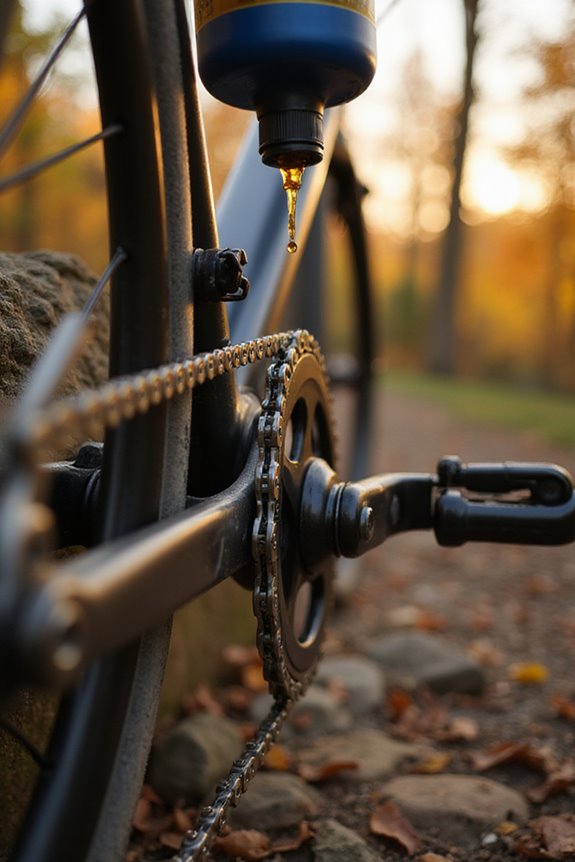
Applying lubricant to a bicycle chain can feel like giving the bike a well-deserved spa treatment, and getting it right is key to ensuring that smooth, effortless ride. First, focus on the inner edge of each roller during chain application, using just a small amount—think of it as feeding your bike a light snack instead of a feast! Drip by drip, avoid those messy sprays that ruin the vibe. Once applied, give the cranks a few backpedals to help the magic happen, and don’t forget to rotate the chain for even coverage. Patience is a virtue here; let the lube soak in properly. Finally, wipe off any excess—your bike deserves a clean finish, too! Happy riding!
Maintaining Your Chain’s Health
Maintaining a bicycle chain’s health is like nurturing a pet; it requires regular attention and care to keep it running smoothly and efficiently. To combat chain wear, riders should lubricate their chains every 200 kilometers under normal conditions, or even sooner in muddy or wet environments. Cleaning is just as essential—using a dedicated chain cleaner can prevent grime buildup that leads to a noticeable efficiency loss. Regularly inspecting the chain for rust or excessive stretch not only prolongs its life but also guarantees peak performance. When it comes to maintenance tips, always dry the chain before lubrication and wipe away excess to avoid dirt attraction. A well-maintained chain means smooth rides and fewer costly repairs down the road!
Tools and Accessories for Chain Maintenance
When it comes to keeping a bicycle chain in tip-top shape, having the right tools and accessories can make all the difference. A good chain cleaning kit, complete with dual-sided gear brushes, can tackle even the grimiest of chains. Chain scrubber devices are fantastic, allowing for thorough degreasing without the hassle of removing the chain. Portable scrubber kits are perfect for those mountain and road biking adventures. For detailed cleaning, multi-brush sets reach narrow gears and derailleur pulley wheels effortlessly. And don’t forget specialty lubricants with pipette systems, making precise application a breeze. With these handy tools, maintaining a clean and well-lubricated chain becomes not just easier, but almost enjoyable—who knew cleaning could be fun?
Storing Your Bicycle Chain Properly
Storing a bicycle chain properly can often feel like a chore, but it’s easier than it sounds and can save a lot of headaches down the road. First, clean your chain thoroughly; nobody wants grime ruining their day. Then, opt for wax or grease-based lubricants for chain storage. These products stick around better and help with rust prevention, especially in humid spots. Store your chain in a dry, low-humidity area, like a garage or attic, away from direct sunlight. To keep things tidy, consider using plastic bags or containers. Don’t forget to label your chains with details like length and brand. After all, a well-stored chain can make your next ride smoother and more enjoyable!
Frequently Asked Questions
How Often Should I Replace My Bicycle Chain?
The frequency of chain replacement depends on chain wear and maintenance schedule. Typically, chains should be replaced every 1,500 to 3,000 miles, with heavier use or harsh conditions necessitating more frequent replacements to guarantee peak performance.
Can I Use Motor Oil for Chain Lubrication?
Using motor oil for chain lubrication is generally ineffective; it attracts dirt and is too thick. Alternative lubricants designed specifically for bicycle chains enhance performance, providing better protection and longevity without the drawbacks of motor oil.
What Signs Indicate My Chain Needs Lubrication?
Signs indicating a chain needs lubrication include increased chain wear, persistent noise levels such as squeaking, and difficulty in shifting. A dry, matte appearance and stiff links further confirm the necessity for lubrication.
Is It Necessary to Remove the Chain for Cleaning?
Removing the chain for cleaning is not always necessary. Effective chain maintenance can be achieved using on-bike cleaning techniques, though complete removal may be beneficial for thorough cleaning in cases of heavy soiling.
Can Environmental Conditions Affect Lubrication Frequency?
Like a delicate ecosystem, environmental conditions profoundly influence lubrication frequency. The weather impacts, coupled with varied riding conditions, dictate the lifespan and effectiveness of lubricants, necessitating adjustments to maintenance routines for peak performance.

